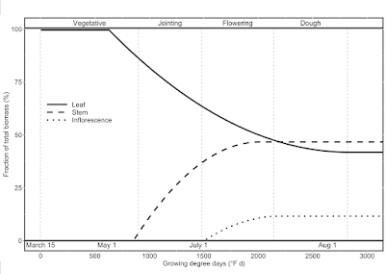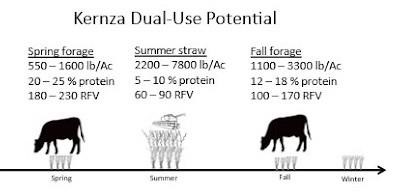By Craig Sheaffer and Jake Jungers
Intermediate wheatgrass (Thinopyrum intermedium) is the first commercially-viable perennial grain crop. The grain harvested from new varieties is called Kernza®, which can be used as a substitute for annual grains like wheat for production of baked goods, breakfast cereals, and snack bars. Kernza has also been fermented for beer production. “MN-Clearwater” is the first Kernza-producing variety developed in Minnesota and has grain and straw yields potential of 800 lb/acre and 8000 lb/acre, respectively. As a perennial, Kernza is planted once and provides several years of harvestable grain and straw. For more information can be found at https://kernza.org/kernzacap/
In addition to producing Kernza grain, intermediate wheatgrass can be harvested for forage. It has been used as a pasture and hay crop in the western USA for nearly a century. Intermediate wheatgrass is a cool-season grass with a growth pattern like other widely grown forage grasses such as smooth bromegrass. When harvested for forage, its yield and forage quality are affected by crop maturity. Intermediate wheatgrass has greatest forage yields beginning at flowering but greatest forage quality at vegetative stages.
Intermediate wheatgrass growth and development
Intermediate wheatgrass begins regrowth earlier in the spring than most perennial cool-season grasses. Plants grow vegetatively and consist mostly of leaves until early May. In response to lengthening days, stems (culms) begin to elongate (jointing) in mid-May with the head (inflorescence) emerging and flowering occurring in early July. Seed formed after pollination is at first milky and progresses to dough and mature seed stages throughout late July and early August.
Intermediate wheatgrass only flowers during the spring regrowth. In Minnesota, Kernza grain and straw is typically harvested about early August with late summer regrowth consisting only of leaves with no stem elongation.
Crop maturity affects forage yield and quality
Maturity is a primary factor determining intermediate wheatgrass forage yield and quality (feeding value). With increased maturity from vegetative to early flowering, forage yield increases while forage quality decreases (Figure 1). This increase in yield is associated with an increase in the proportion of stem and a decline in leaf proportion as stems elongate (Figure 2).

Figure 1. Intermediate wheatgrass forage yield increases with maturity, while relative forage quality (RFQ) declines.

Figure 2. Intermediate wheatgrass leaf, stem, and inflorescence fractions change with maturity. Leaves predominate early in the season while stems predominate at flowering. Leaf loss from lower in the canopy can contribute to decline in leaf proportion.
Reduced leaf to stem ratio is the primary cause of forage quality decline with maturity. Leaves are higher in nutrients and relative feed value than stems and lower in fiber (Table 1). Leaf quality declines less with maturity than stem quality because of a rapid increase of fibrous, structural components of stems as they elongate.
Table 1. Forage quality of intermediate wheatgrass leaves and stem at initiation of stem elongation and at anthesis (pollen shedding). Leaf blades only were analyzed. Leaf sheaths were attached to the stem.
| Maturity stage | Component | Component
proportion | Crude protein | Relative forage
value |
|---|
| | | % | % | |
| 2-nodes | leaf | 57 | 21 | 126 |
| | stem | 43 | 12 | 95 |
| Anthesis | leaf | 28 | 19 | 113 |
| | stem | 56 | 7 | 68 |
| | inflorescence | 16 | 7 | 89 |
Dual-use harvests for grain and forage
In grain production systems, forage can be harvested in the spring before the initiation of stem elongation and in fall following regrowth after grain harvest (Figure 3). In both spring and fall, intermediate wheatgrass will be vegetative and low growing and grazing may be the best approach to utilization. Because the forage is vegetative it is high quality. Straw that is mostly stems can be used as bedding or harvested and mixed into livestock rations. Fall forage grazing can increase net returns per acre by 10-20% compared to only grain and straw harvest, but grazing in the spring after tiller elongation can adversely affect grain yields due to removal of seed heads.
Yields of both forage and straw will be affected by N fertilization. Rates of 80 lbs. of nitrogen per acre are commonly recommended for grain production.
Harvest as a hay crop
Intermediate wheatgrass can also be harvested exclusively as a hay crop using similar strategies as used for traditional cool season forage grasses. Hay harvest is likely most economically viable in older stands when production of Kernza grain decreases. Intermediate wheatgrass is a cool season perennial like orchardgrass or smooth bromegrass and that produces most of its forage during the first spring growth and smaller amounts in the late summer and fall. Forage harvesting decisions are a compromise based on forage yield and quality goals (Figure 1).
We compared the forage yield and relative forage value from harvest systems when the first harvest occurred at boot stage vs. dough stage. For the first harvest, forage yield was higher for intermediate wheatgrass harvested at dough stage than when harvested at boot (Figure 4). Fall yields (harvests in September and October) following post-grain harvest regrowth were less than for the first harvest and were greater when the first harvest was at boot stage. Cumulative growing season forage yields were strongly influenced by the first harvest yields and averaged 1.8 and 2.1 T/acre for the boot, and dough first harvest systems, respectively. These yields were a function of the N fertilizer rate of 60 lbs. per acre applied to 3-year-old stands and would be increased at higher N rates.
Forage relative feed value (RFV) is an indicator of forage quality and was greatest at the boot stage first harvest and declined at dough stage. The RFV for subsequent harvests was similar for the two systems and reflects the vegetative maturity of the crop.

Figure 3. Use of Kernza intermediate wheatgrass for both
grain and forage production

Figure 4. Summer and fall forage yield and relative feed value (RFV) of intermediated wheatgrass when the summer harvest occurred at boot or dough stage.
We have not measured persistence of intermediate wheatgrass stands in Minnesota under different forage harvest systems, however, previous research in dryer regions has shown that its persistence is reduced by three or more harvests during the year. Therefore, we recommend harvest systems with only a summer and fall harvest in Minnesota until more research is done.
Source : umn.edu